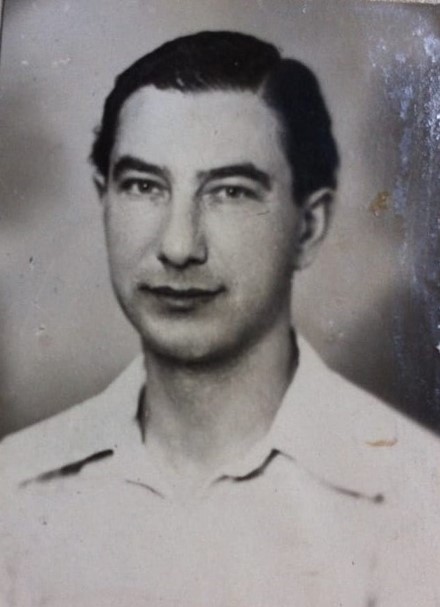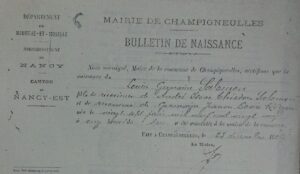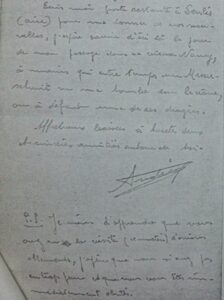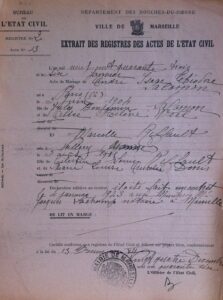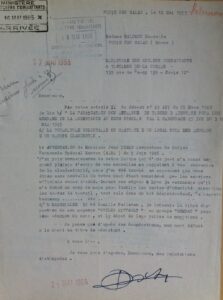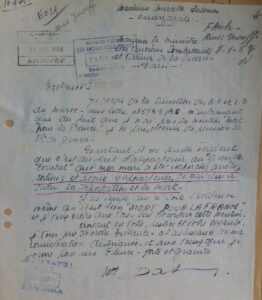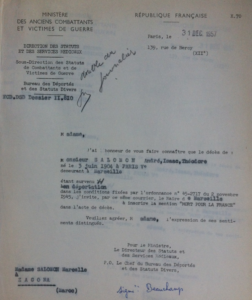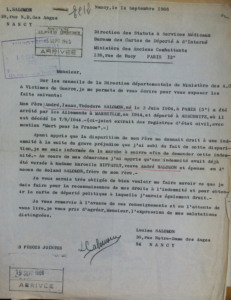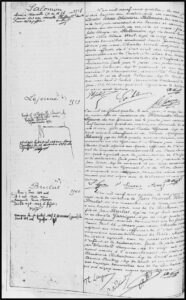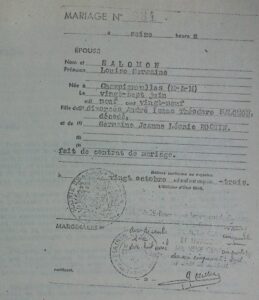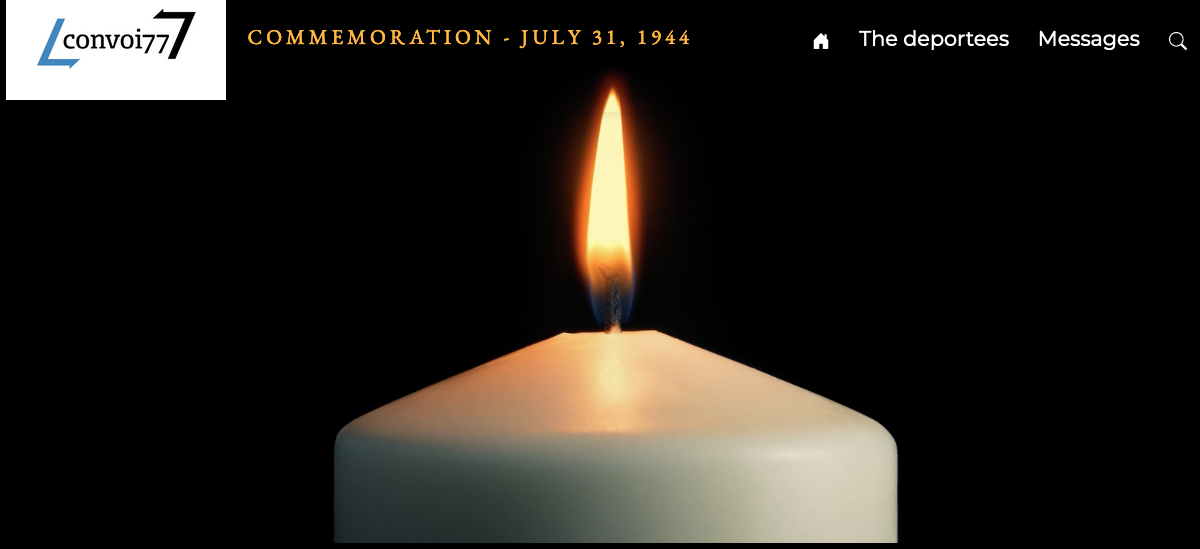André SALOMON
André Isaac Théodore Salomon was born on June 3, 1904 in the 5th district of Paris, was arrested on June 21, 1944 in Lyon, in the Rhône department of France. Interned initially in Montluc jail in Lyon, he was transferred to Drancy internment camp on July 24 1944 and deported to Auschwitz on July 31 1944. He was later officially declared to have died on August 7, 1944.
Portrait of André Salomon
Victims of Contemporary Conflicts Archives Division of the French Ministry of Defense Historical Service, ref. 21P 535 161
André’s life before the Occupation
André Isaac Théodore Salomon was born on June 3, 1904 in the 5th district of Paris. HIs parents were called Jules Benjamin Salomon and Alice Hélène Weil. They ran a hardware shop. Two of his paternal uncles also worked in the commercial sector: one bought and sold shoes and the other was a tailor.
The family grew larger on April 18, 1906 when André’s little brother, Roland-Marc, was born.
André got married for the first time to Germaine Jeanne Roquin. The couple had a baby girl, Louise Germaine, on June 27, 1929 in Champigneulles, in the Meurthe-et-Moselle department of France. André Salomon was a sales negotiator.
Louise Salomon’s birth certificate (1929)
Victims of Contemporary Conflicts Archives Division of the French Ministry of Defense Historical Service, ref. 21P 535 161
The marriage only lasted four years: the couple got divorced in 1933.
He appears to have kept in touch with his daughter and ex-wife however, as revealed by a letter written on May 10, 1940, at the start of the German assault during the Battle of France. At the time, he was stationed with his regiment at Charleville-Mézières, in the Ardennes department of France. This is what he wrote:
“Dear Germaine,
You see, I’m keeping my promise for once, I’m writing to you as I said I would.
[…] Write to me poste restante in Senlis to tell me all your news. I hope to know by then the day on which I’ll be in Nancy, unless a Messerschmitt falls on my head in the meantime or, at the very least, one of its their bombs. Affectionate kisses to both of you and sincere best regards to everyone in your life.
PS: I’ve just heard that you had a visit (this morning) from some German bombers. I do hope you weren’t too frightened and went straight to the shelter.”
Part of André Salomon’s letter (10 May 1940)
Victims of Contemporary Conflicts Archives Division of the French Ministry of Defense Historical Service, ref. 21P 535 161
During the Occupation
André Salomon went into hiding in Marseille, in the Bouches-du-Rhône department of France, which was in the non-occupied “free zone” in the southern part of the country.
He got married for the second time, to Marcelle Riffault, on January 6, 1943 in Marseille. His brother was one of the witnesses at the wedding. Marcelle was born on August 3, 1915 in Vallery, in the Yonne department of France. Her father worked in a bakery and her mother was a dressmaker. Marcelle, who was the manager of a bicycle store, was around ten years younger than André. The couple lived at 32, avenue Camille Pelletan in the 3rd district of Marseille.
André Salomon and Marcelle Riffault’s marriage certificate (1943)
Victims of Contemporary Conflicts Archives Division of the French Ministry of Defense Historical Service, ref. 21P 535 161
André Salomon was arrested on June 21, 1944, either in Lyon or in Saint-Étienne, depending on the source. He was interned at Montluc jail in Lyon until July 24, when he was transferred to the Drancy transit camp. A Red cross nurse gave his wife an envelope dated July 28, which contained two messages.
The first message, dated July 5, was sent from Montluc jail. André asked his wife for some clothes: some shirts, pajamas, old pants, a pullover or an old jacket. He also assured his wife that he was in good health.
The second was dated July 22, 1944. Also written in Lyon, he asked for a (baptism) certificate and gave his wife some instructions about orders for the store. If he could show a baptism certificate, it was possible that he would be released. His wife explained the reason that he was in Saint-Étienne as follows:
“We were wanted by the Gestapo, who came to boulevard du petit Nice […] to arrest us. My husband went to Lyon to see his boss, whose name I don’t know, and from there he went to Saint-Étienne to order supplies for our business, hence the list of purchases and orders as well as these locations”.
The letter also reveals that André Salomon’s parents were still alive, and that he fondly called his wife “Célo”. According to this information, André Salomon worked in business liaison. We shall come back to this in more detail later on.
André Salomon was deported from Drancy to Auschwitz on Convoy 77 on July 31, 1944. He was never heard from again.
André’s wife’s search for him after the war
Marcelle Salomon tried to find out what had happened to her husband. She was granted a permanent pass to go to the Saint-Charles station in Marseille to help to meet convoys of repatriated prisoners. She hoped that André would be one of them.
A missing person’s certificate was issued for André on July 27, 1946. His death was entered in the registry on February 11, 1947. The official date of death was listed as August 7, 1944, this being just a few days after he arrived in Auschwitz.
On October 11, 1948, in La Fouilloude, in the Loire department, Marcelle Riffault got married again. Her new husband was Roland-Marc Salomon, André’s younger brother. Roland had been a member of the Resistance. He was detained in Montluc jail in Lyon from January 26, 1943 to September 21, 1943, but escaped to via Spain to North Africa, where he joined the Free French Forces.
The couple set up home in Fqih Ben Salah, in Morocco.
André Salomon’s official status
The families of murdered deportees had to undertake some complicated formalities.
Deported people could be granted one of two official titles: “political deportee” or “deported Resistance fighter”.
In 1955, André Salomon was awarded the status of “political deportee”, meaning that he had been deported on for political reasons.
However, André’s widow requested on several occasions that her late husband be granted the status of “deported Resistance fighter”. She gave various reasons for this. When he was in Lyon, he had helped to produce false identity cards and work permits. Marcelle Salomon herself had let the “Combat” group use her bicycle store, “Cycle Riffault”, to hold meetings in the evenings and to store suitcases filled with ammunition. She provided a witness statement from Jean Icart, a police inspector who also belonged to the Resistance. She would not give up, and sent a number of letters. She also noted that André used several different pseudonyms during his time in the Resistance: Leclabart, Denis and Riffault.
Marcelle’s request for a “deported Resistance fighter” card for André (1955)
Victims of Contemporary Conflicts Archives Division of the French Ministry of Defense Historical Service, ref. 21P 535 161
Marcelle’s request for a “deported Resistance fighter” card for André (1956)
Victims of Contemporary Conflicts Archives Division of the French Ministry of Defense Historical Service, ref. 21P 535 161
In 1957, the Ministry of Veterans’ affairs and Victims of War rejected Marcelle’s request for “deported Resistance fighter” card from André. It explained its decision as follows:
“The determining motive for the deportation was not an action classified as resisting the enemy as defined in the statute on Deported and Interned Resistance Fighters”.
An investigation had already been carried out in 1949, and had concluded that there was no evidence to prove that André Salomon had participated in the Resistance movement.
Information memo (1952)
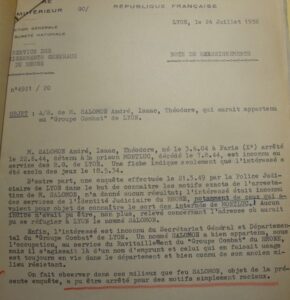
French Defense Historical Service archives in Vincennes, Resistance records, ref. GR 16 P 532767
The words “Mort pour la France”, meaning “Died for France” were added to André Salomon’s death certificate.
Attribution of the status “Mort pour la France”, meaning “Died for France” (1957)
Victims of Contemporary Conflicts Archives Division of the French Ministry of Defense Historical Service, ref. 21P 535 161
However, this was not the end of the story. The Salomon family later quarreled about who should receive compensation. The pain of losing a loved one was made even worse by this disagreement.
Family disagreements
In 1966, Louise Salomon, André Salomon’s only child from his first marriage, wrote to the Department of Veterans’ Affairs. She felt she had suffered significant material loss, and asked what she should do to claim her entitlements. She was referring to a compensation payment made by the Federal Republic of Germany to “French victims of National Socialist persecution”. It was originally payable to André Salomon’s mother, but since she had died, it was paid to his brother, Louise’s uncle Roland. This late request reveals that Louise was no longer in touch with the Salomon family.
Louise Salomon’s letter to the Ministry of Veterans’ Affairs (September 14, 1966)
Victims of Contemporary Conflicts Archives Division of the French Ministry of Defense Historical Service, ref. 21P 535 161
Louise filed an official complaint against “X” (an unknown person or a person who the plaintiff does not wish to identify) for misappropriation of funds.
The French military police summoned Roland and Marcelle Salomon to attend the police station on December 4, 1968, in order to hear their side of the story. Marcelle was questioned first, and declared that she had married André in January 1943, and that they had never had children. According to the official French family record, André had never married and had never had any children. This left Louise’s identity a mystery., officially speaking. Marcelle also explained that she had withdrawn her claim for compensation and arranged for it to be paid to her mother-in-law.
Roland was questioned next, and stated that he did not know that his brother had ever had a daughter. André had never spoken to him about her. He had only found out about her during the questioning. He felt that he owed Louise nothing. The family record lists André Salomon’s birth, and beside this is a note in the margin that he married in 1943, but there is no mention of a child.
André Salomon’s birth record (1904)
Paris civil register
He had definitely been married to Germaine Roquin, however, as can be seen on the following certificate:
Victims of Contemporary Conflicts Archives Division of the French Ministry of Defense Historical Service, ref. 21P 535 161
The public prosecutor’s office rejected Louise’s claim and let Roland keep the money, on the grounds that Louise had applied for compensation too late. The Ministry of Veterans and Victims of War deemed that the claim was not within its remit, but was a matter of inheritance law. This tragic and convoluted episode thus tore the Salomon family apart over an unfortunate dispute about money.
Madeleine Riffault died in Poitiers in the Vienne department of France, on March 21, 1973. Roland Salomon died on September 17, 1988. Louise Salomon died in Metz, in the Moselle department of France, on September 30, 2023, just as we were beginning our research into au André Salomon. She had no children.
André Salomon’s story illustrates how difficult it was, after the war, for the French authorities to acknowledge or prove that Jews had been involved in resistance activities during the Occupation. While they readily granted the status of political deportee, it was much harder to qualify for the status of deported resistance fighter.
Sources
French Defense Historical Service
- Victims of Contemporary Conflicts Archives Division of the Ministry of Defense Historical Service, ref. 21 P 535 161
- French Defense Historical Service archives in Vincennes, Resistance records, ref. GR 16 P 532767
Shoah Memorial in Paris
- Drancy files, deportation list
Paris municipal archives
- Civil status register
Note from Martine Hublin
My drawing portrays André Salomon, who was deported on Convoy 77 during the Second World War. I decided to illustrate what happened during the war by drawing a portrait of Mr. Salomon, which is based on a copy of the only photograph of André that we have in our possession. In my drawing, I included weapons, tanks, soldiers, tears and other tragic details in his hair and on his face, to show the true face of war and the suffering it can bring. Lastly, I added a “Jewish” star to illustrate the status to which André Salomon was reduced.
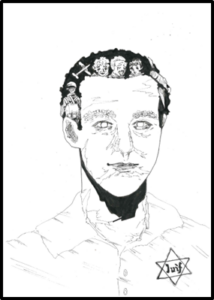


 Français
Français Polski
Polski